New Orleans is a drinking city. From the oldest bar in America, to legally being able to take your drink outside in a “go cup,” to drive-through daiquiris, and the invention of the Sazerac cocktail, NOLA is all about booze culture. But where to go? The city is packed with bars, so on my recent visit with my dog Karl, I checked out quite a few — and now present the top three spots. Continue reading
Category Archives: culture
Chips, Dips, Chains and Whips at Australia’s Mindil Market
Every Thursday and Sunday evening the world meets at the beaches of Darwin, Australia, in the famed Mindil Market. Continue reading
Exploring the Dinosaur Graveyard in the Jurassic World of Mongolia

Photo by Getty Images. Design by Lauren DeLuca for Yahoo Travel.
Deep in the Gobi Desert is an explorer’s dream: a real life dinosaur graveyard. Sixty million years ago, velociraptors and other dinosaurs roamed this part of the earth, which was then a grassy, leafy area. Now a stark desert, it is filled with their bones.
This site, Byanazag, otherwise known as the Flaming Cliffs, is especially famous because in the 1920s, American paleontologist Roy Chapman Andrews discovered dinosaur eggs there — proving dinosaurs were reptilian and didn’t have live births. Today, discoveries are still made every day.
Related: Class War: Filthy Rich v. Dirt Poor in Mongolia

The Flaming Cliffs of Mongolia are full of dinosaur bones.
Unlike sites in other parts of the world, in Mongolia you can still wander around unobstructed on these cliffs. What looks like stone may be bone, but you have to lick it to see.
My guide, Timur Yadamsuren from Intrepid Travel, elucidated: “You have to lick it — if your tongue sticks to it, it is bone. If it doesn’t, it is stone.” [Note: It is entirely possible Timur was messing with me and just wanted me to lick a bunch of stones, but some did stick and others didn’t so…]
Related: Hospitality or Hazing? Surviving a Vodka-Fueled Night in Mongolia
However, if you do find dino bones (and, according to my sticky tongue, I did), it is illegal to remove them.
“You must take them to the museum or alert the government,” according to Timur.
An added bonus to this graveyard is the landscape, which, not unlike the Badlands in South Dakota, is made up of red and orange sandstone. So when the sun sets and the light strikes the cliffs, they look like they are on fire (hence the name, the Flaming Cliffs). It is a truly magical, mythical place and not one to be missed, especially for those of us who grew up dreaming of dinosaurs.
Thanks to Intrepid Travel for showing us such a good time in Mongolia!
Want more? Check out me getting Hazed by a Nomad Family in Mongolia:
Class War: Filthy Rich v. Dirt Poor in Mongolia
Last year, Mongolia topped many people’s bucket lists, and slowly but surely tourists have been streaming into the land of Genghis Khan — but upon arrival in the capital, Ulaanbaatar, many are shocked. In a city of 1.3 million, over 60 percent live in utter poverty in the ger (tent) districts, some of which are nestled right next to gleaming new high rises that house newly minted millionaires and billionaires. Continue reading
Hospitality or Hazing? Surviving a Vodka Fueled Night in Mongolia
When one thinks of hazing, one usually thinks of college fraternities and sororities. But, my friends, the American Greek system has nothing on the Mongolian nomads.
During my trip to Outer Mongolia this summer, I learned about the Nomad Code — which, according to my guide, Timur Yadamsuren from Intrepid Travel, is basically, if anyone rolls up on your door, you have to give them food, drink, and shelter. “If you don’t, they might not survive. And the next time you are traveling, they will give you shelter — or you might not survive.”
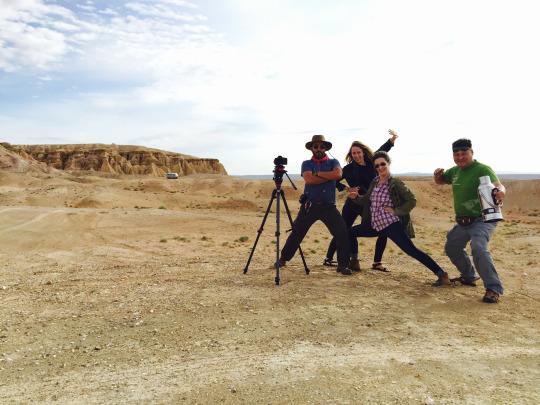
The road trip started off so well… and sober.
Related: How to be a True Nomad: Milking Camels in Mongolia
My crew and I called on this Nomad Code outside of the Singing Sand Dunes in the Southern part of the country, with a friendly ger (yurt) family headed by Ankhaa. We were quickly joined by his curious neighbors. But Timur had neglected to tell us about Mongolian hospitality — or, as Americans might call it, hazing.
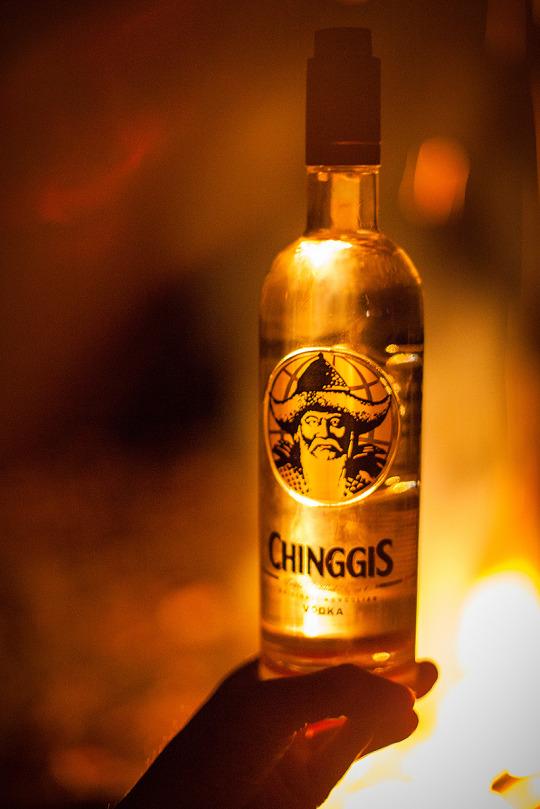
The local poison sold at every kwickie mart in the country. Photo credit: Richard Hirst/Flickr.
After eating camel milk curd, drinking camel milk tea, and then milking said camels to replenish the liquids we had downed, my crew and I were about to go on our way when we remembered the bottles of vodka we had bought for presents to give out to helpful families during our road trip. Our host Ankhaa and his neighbors definitely qualified, so we whipped out a bottle of Chingghis Khan vodka for the families.
What we didn’t realize is that if you present a bottle, you are also expected to drink it with the host. We also were unaware that Mongolian “shots” are soup bowls, and you are expected to down it in one go … and that you cannot have just one.
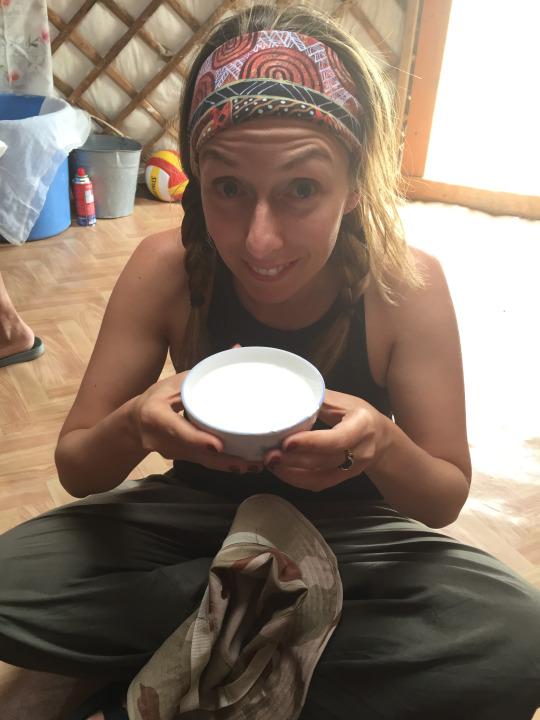
My producer Nicola with her fifth bowl of vodka. Togtoy!
How to Milk A Camel in 5 Easy Steps
Because you just never know when you’re going to need this knowledge. Trust.
For all the awesomeness, subscribe to my YouTube channel, HERE!
Going Full Nomad in Mongolia – It Can be Done!
This summer, I fulfilled a lifelong dream: visiting Mongolia. I’d read about Genghis Khan and his conquests for years and had always wanted to visit — a bucket list dream come true, if you will. I decided to do a road trip, as, 800 years after the Great Khan died, over one-third of the population still leads a nomadic lifestyle, living in gers (yurts), with their cattle (camels, cows, goats, and yaks) roaming the fields outside. Not much has changed over the years except for the method of transportation. In the older days, the ger would be wrapped up and put on a camel’s back for the move to fertile fields, while today, it is loaded up on a truck.
Related: The Ancient Trading Towns of Oman – An Explorer’s Dream
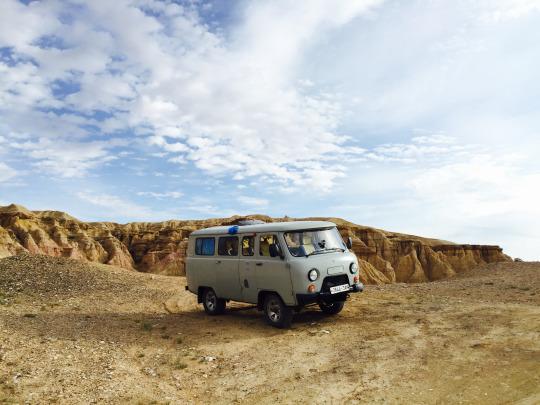
My chariot on the ultimate Mongolian road trip — an old-school, soviet-style van with no shocks and no seat belts. (Photo: Paula Froelich)
And, as there are few hotels outside of the capital, Ulaanbaatar, one must rely on the Nomad Code to survive. Which basically means rolling up on an unsuspecting family and asking to spend the night.
My guide, Timor from Intrepid Travel, explained.
“If someone comes to your door, you must give them food and shelter,” Timor said. “Or they might not survive. And the next time you are traveling, they will give you shelter — or you might not survive.”
Related: Travel Back in Time With the Bedouin of Jordan

Welcome. Yurts, or gers, like this are seen throughout the country. (Photo: Paula Froelich)
The first ger we rolled up to was outside of the singing sand dunes. It had been a long day and I had climbed a 50-meter-high sand dune. I was hungry, dirty, and tired. Thankfully, Ankhaa, the owner of the yurt, was hospitable.
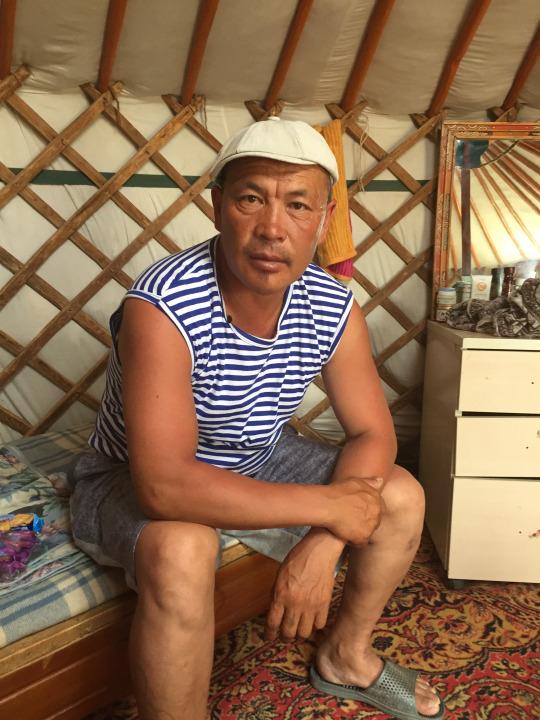
Ankhaa in his ger, looking very Jean Paul Gaultier. (Photo: Paula Froelich)
WATCH: The Hunt for the Louisiana Swamp Monsters
According to Cajun legend, deep in the Louisiana Swamp is the Rougarou — a large, werewolf-like half-man, half-beast creature who preys on people who venture too far into its terrain.
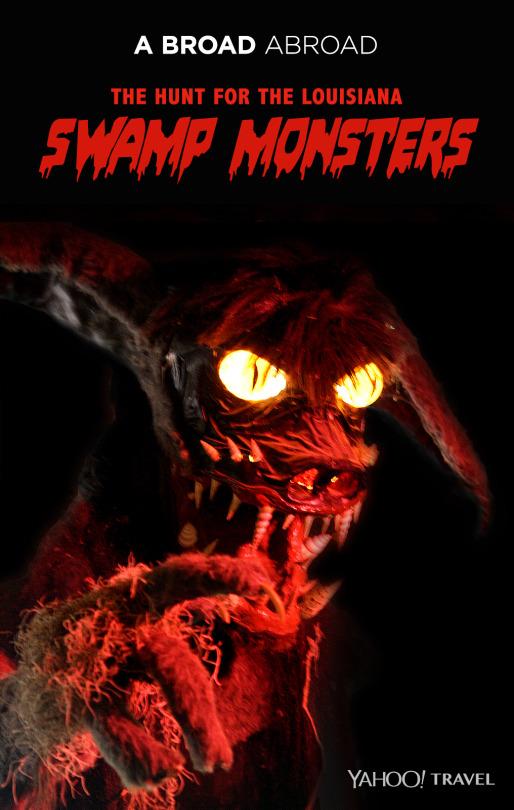
Photo (modified) by Angie Garrett/Flickr. Design by Lauren DeLuca for Yahoo Travel.
Regarding this legendary beast, History.com says, “The Cajun legend of the Rougarou can take on multiple forms. Originally derived from French stories of the ‘loup-garu,’ or ‘wolf man,’ the monster is most commonly described as a bayou-dwelling werewolf with glowing red eyes and razor-sharp teeth. The beast is usually said to be a cursed man who must shed another’s blood in order to break its spell and reassume human form, but the tale varies according to the teller. In some versions, the Rougarou can turn its victims just by locking eyes with them; in others, it takes the form of a dog or pig rather than a wolf. Still others paint it as a shape shifter that can assume different human and animal forms at will. Because it can switch its appearance so easily, some even conflate the creature with the legendary Skunk Ape of southeastern U.S. swamp lore. In most Louisiana parishes, the Rougarou myth is employed as a kind of cautionary tale. Children are told that the fiend will come for them if they don’t behave, and Catholics are warned that it hunts down those who break Lent.”
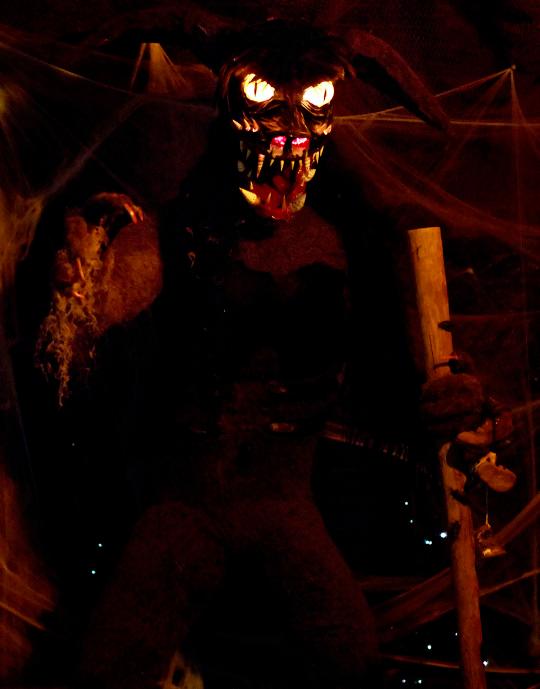
A rougarou on display at the Audubon Zoo in New Orleans. (Photo: praline3001/Flickr)
Since I was in that neck of the woods, I decided to try and see it for myself and check out another supposedly tall tale — the ginormous DinoGator, an alligator that measures up to 50 feet long. Think Lake Placid on steroids.
Related: Inside the Cage of Death With Australia’s Monster Crocs
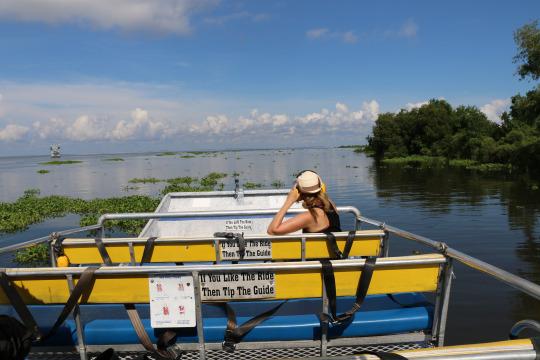
Ready for my monsters.
Americana Rules! Inside The Best Little Carnie Museum In Louisiana
I love Americana. The Big Ball of String versus the Largest Ball of Twine? Yes please! Every state has its oddities and awesomeness. Texas has The Beer Can House in Houston, Washington has the ginormous Milk Bottles in Spokane, California has the Cabazon Dinosaur statues, Oregon has the largest Paul Bunyon statue and Louisiana has… the Abita Mystery House.
On the road from New Orleans, LA, to Biloxi, MS, is the small town of Abita Springs, where John Preble set up his popular and odd roadside attraction, the Abita Mystery House.

The entry to the Abita Mystery House.
Open for over 15 years, the “Mystery House” – also known as the UCM Museum, is a maze of buildings, starting with a vintage gas station (now a gift shop – more on that later), a hot sauce house that is home to every kind of hot sauce in the world (supposedly), and an exhibition hall which houses miniature small town scenes that poke fun at traditional Southern life including Mardi Gras parades, UFO landings, alligator wrestlers, Carnivals and more.
But the real precious items are in the House of Shards – where real live carnival exhibits, once seen on the road and believed by millions to be genuine artifacts are on display.
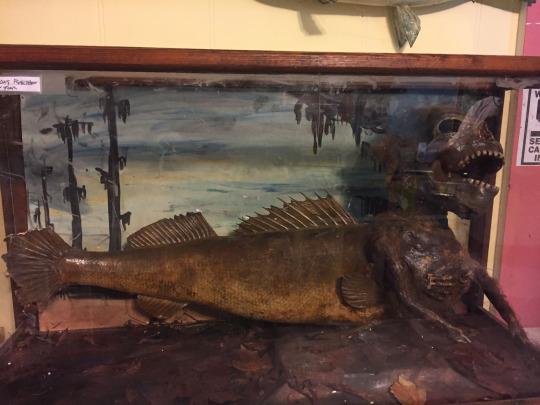
The original Merman!
Mixed in with a huge “Bassigator” (a fearsome looking half bass, half alligator animal that needs to appear in a SciFi movie stat), and a “real life UFO landing!” that consists of an airstream trailer with aliens plotting world destruction on the inside, are the old time fortune telling booths. Pop in a quarter and you get your fortune – which usually exhorts you to spend more money, naturally.
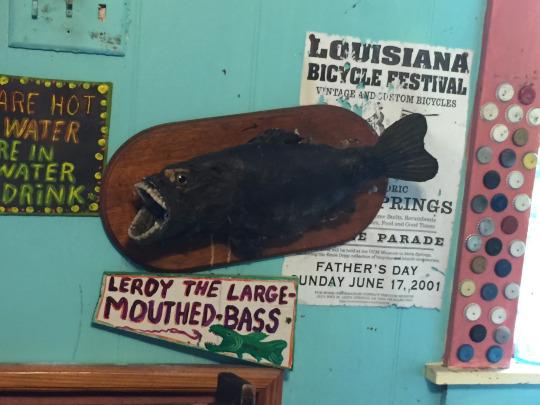
Leroy has some serious chompers.
Inside New Orleans’ House of Dance and Feathers
Tucked away in the Lower Ninth Ward, just blocks from where the levee broke, is a unique museum, even for New Orleans. Located in a building in the back of 1317 Tupelo Street is the House of Dance & Feathers — a rough-and-tumble museum dedicated to the Mardi Gras Indian tribes. Founded by Ronald Lewis, the head of the Choctaws, the museum is full of feathered headdresses, intricately beaded chest plates, glittery costumes and, in the corner, a case of water worn shoes, that, despite the wear, still hold their fabulousness.
Related: The Stolen Generation: Australia’s Dark and Tragic Past
“Those were my shoes that were all ruined by Katrina,” Lewis said. “Ostrich, alligator — thousands of dollars of my good shoes just ruined. I used to wear them during the parades, but now I place them there to remind people of what was lost. They’re still too nice to throw away.”

Lewis hand-beaded this chest plate and saved it from Katrina.
Ten years ago when Katrina hit, Lewis’ home and museum were covered in flood waters.
“I lost pretty much everything that I didn’t take with me,” he said. “I grabbed these beaded works and a few other things, and my wife and I fled. When I came back it was all gone.”
Lewis and his wife spent almost a year with family in Thibideaux, La., before coming back to New Orleans and rebuilding from the ground up — with help from “the great people of America.” Lewis, like many families in the Ninth Ward, didn’t receive direct compensation from the government or the Red Cross. “Fortunately, I was on NPR and so donations came in,” he said. “Don’t get me started on the government ‘funds’ or the Red Cross.” He shakes his head. “I don’t like to dwell on bad feelings.”
Related: This Burmese Nunnery Saved 300 Girls From Sex Slavery
Just last month, Lewis finally put the finishing touches on his house and museum.

Ronald outside his museum. (Photo: House of Dance & Feathers)
“I’m trying to keep this culture alive. It started in slavery, when the slaves were allowed out on Sundays — the only day they could congregate — to Congo square and they would beat the drums with the Indians. We learned form the Indians and started our own tribes — which march in Mardi Gras and in weekly parades from September to May.”
